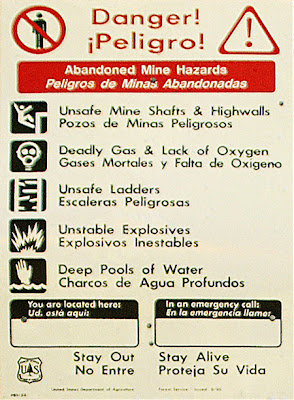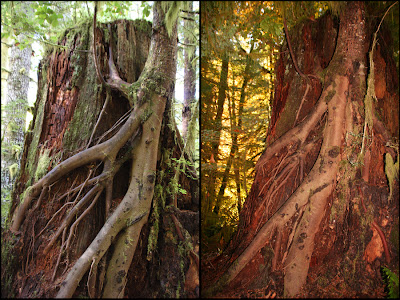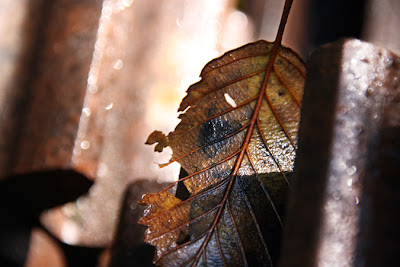I glanced over to the Monkey-cam and shrugged, “Might as well check it and see if it’s really locked.” But it turned out it was really locked.
 Just around the corner was an abandoned work shed with one of the most intimidating danger signs I’ve ever read.
Just around the corner was an abandoned work shed with one of the most intimidating danger signs I’ve ever read.“This,” I said, turning toward the Monkey-cam, “looks like a job for the Monkey-cam.”
The Monkey-cam studied my face. I could almost hear the little wheels spinning in his head. He looked at the mine shaft again, looked at the danger-sign graphics, and reluctantly reached into his pack for his crash helmet while doing a nervous little potty dance.
Trembling, the Monkey-cam cinched his chin strap. I couldn’t keep a straight face any longer. “I’m joking, you little dork.” I finally confessed.
We went back to peer through the gate into the depths of the mine shaft, but it was dark and we couldn’t see anything.

I reached into my pack for the safety matches and pretended like I was going to strike one on the side of the box to light it. The Monkey-cam took one look at the matches, dropped his back-pack and was one-hundred yards away within six seconds. That’s when I realized he could read.
 (click on image to view larger version)
(click on image to view larger version)
We spent some time exploring the falls below the rickety old work shed.


And molten water

The trees donated their gold to the local eco-system.
Sometimes, when an old friend dies, it is hard to let go.
(Note: Usually, my camera is way smarter than I am and it does an O.K. job of exposing pictures, but after reviewing the picture on the left, I was disappointed to see that in order to properly expose the tree, the background got washed out. I thought maybe if I used the flash as fill, I might be able to capture the light in the background filtering through the forest canopy from the rising sun, but I’m not sure I like how flesh-like the tree turned out.)
Along the road, there is deserted mining machinery - wheels, gears, chains, boilers, and sections of rail – cast off and forgotten like autumn leaves.
By the time I got to Sawmill falls (at least I think it was Sawmill falls), the sun was finally rising above the hills and poking fingers of light into the valley.
I liked how the sunbeams highlighted sections of the falls.


The lazy October sun haphazardly set about drying the ancient forest here and there.
Under the sun’s gaze, dew-laden webs dried and returned to functional invisibility.
The understory illustrated.
The under - understory

A scene from Opal Pool
I set up the tripod and took a long exposure looking down into the water of Opal Pool. The orange-brown streak at the water’s surface in front of the red rock is the path of a leaf headed downstream (admittedly, it's hard to see).
Looking downstream from Opal Pool

The business part of this bridge is a single tree with the ‘top’ side flattened a little. The fuzzy effect isn’t due to a Photoshop filter. Evidently, if I hold my camera while I’m hiking in cool weather, I create a temperature differential that causes some condensation problems with the UV filter on the front of the lens.

On the path to Cedar Flats, I encountered an area rich with understory and I spent some time trying to catch an image that would depict the delicate calligraphy-like structure of the sheltered yellow canopy of deciduous leaves. It was hard because there isn’t anything obvious to focus on. Even worse, in the dim light of the ancient forest, the depth of field is so narrow that almost nothing is in focus anyway.
Frustrated I turned away only to find this giant cedar watching. To my lasting shame, I didn’t manage to get this picture in focus either.
Ultimately, underneath the pines and cedars, underneath the deciduous understory, underneath the bushes and ferns, lies the forest floor, covered in a rich shag layer of moss.
Cedar Flats



















there, ethereal
ReplyDeleteweb in gold light and shadow
life's fragile beauty